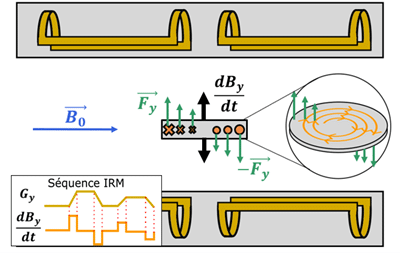New MRI vibration assessment method now available at Healtis
Healtis enriches its test catalog by integrating the Tier 2 method for evaluating vibrations induced by MRI gradients, in accordance with ISO/TS 10974:2018 – Clause 10.
This is an ideal opportunity to review existing approaches and choose the most appropriate method for your medical device.
Why assess vibrations in MRI?
During an MRI examination, devices may experience vibratory forces generated by the interaction between the static magnetic field, magnetic field gradients and the conductive parts of the device.
These vibrations may :
- cause discomfort or pain to the patient,
- disrupt the operation of active implants.
Representation of induced vibrations in MRI
What factors influence vibrations?
Tier 1 method (ISO 10974 – Clause 10)
Method principle: Evaluate device operation before and after exposure to MRI-induced vibrations.
Advantages: Relatively simple method for assessing device operation after MRI.
Limitations :
- Requires considerable MRI time,
- No quantitative vibration measurement,
- Difficult to achieve recommended exposure levels, especially at 3T.
Tier 2 method (Clause 10 of ISO10974) – Laser vibrometry & vibrating pot
- Vibration measurement using laser vibrometry. Considered the reference method for vibration measurement, this technology is insensitive to electromagnetic interference and operates without contact. A special experimental set-up is used to measure the radial vibrations of the device.
- Reproduction on a vibrating pot to assess the impact on the operation of active devices.
Velocity profile of an implanted active device under the effect of MRI-induced vibrations
Advantages :
- Precise quantification: amplitude and frequency,
- Allows tissue risks to be assessed,
- Exposure limits are greatly extended,
- Possibility of adding safety margins by amplifying the vibration profile on a vibrating pot,
- Optimization of MRI time,
- Can be adapted to assess tissue risks associated with passive devices.
Drawbacks
- Requires two steps: vibration measurement and reproduction,
- More complex to implement,
- Additional data processing.
Expert testimony
“Particular attention must be paid to the choice of device orientations and positions in the MRI, as well as to the selection of vibration measurement points, to ensure that conditions correspond to the worst-case scenario.”
Diego González Soto, PhD student at Healtis and principal designer of the method.
Which method to choose?
ISO/TS10974 defines two possible methods for assessing the impact of vibrations induced by MRI magnetic field gradients:
- Method 1 (Tier 1): this is a simple and effective approach, used to determine whether vibrations can damage a device. However, it does not quantify vibration amplitudes.
- Method 2 (Tier 2): more complex to implement, this method quantifies the amplitude and frequency of device vibrations.
Our team remains at your disposal to define the vibration evaluation strategy best suited to your needs.
Contact us today at [email protected] !





